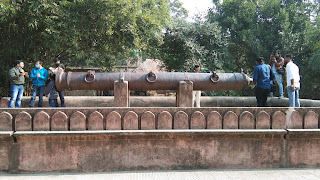Jahan Kosha vintage view.
Jahan Kosha Cannon (also known as the Great Gun) or Jahan Kosha Kaman, is placed in Topekhana of Murshidabad, WB. It literally means the Destroyer of the World(Jahan = World, Kosha = Destroy).
The cannon was made in 1637 CE by Janardan Karmakar, a Hindu blacksmith and gunsmith, under the supervision of Hara Ballav Das.
The cannon is made of ashtadhatu or 8 metals, namely lead, iron, silver, copper, tin, zinc, gold and mercury. Ashtadhatu, also called octo-alloy, is a mix of alloy often used for casting metallic idols in Hindu temples. The composition is laid down in the Shilpa shastras, a collection of ancient texts that describe arts, crafts, and their design rules, principles and standards.
The cannon is more than 7 tons in weight. It is 17 feet and 6 inches in length and 3 feet in width. It has a girth of 5 feet at the touch hole end. The circumference of its mouth is more than one foot. The radius of the touch hole is one and a half inches. In order to fire this cannon once, 17 kilograms of gunpowder was needed. The bore is approximately 6 inches.
The wheels of the gun carriage have disappeared, but the iron-work of the carriage and the trunions are still visible.
The cannon is maintained by the Archaeological Survey of India.

